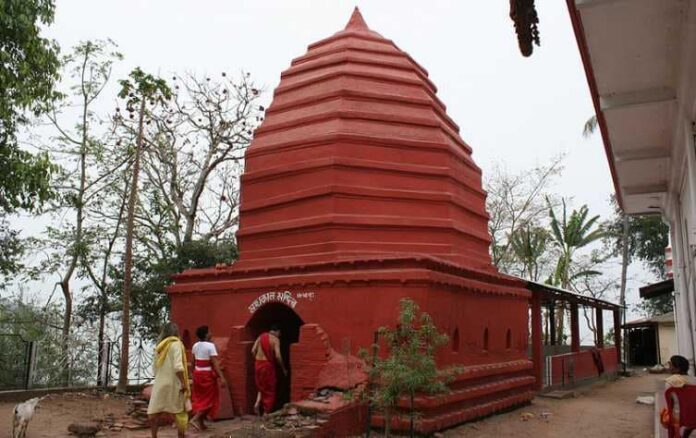Umananda temple, located on the Peacock Island, is one of the important temples of Guwahati. Situated in the middle of River Brahmaputra, this temple is dedicated to the worship of Lord Shiva.
The Umananda Temple, constructed in 1964 AD under the patronage of Ahom King Gadadhar Singha, a devout Shaivaite, stands as a testament to devotion on the tranquil Peacock Island.
This island, nestled amidst the flowing waters of the Brahmaputra River, claims the title of the world’s smallest inhabited riverine island, boasting a minimal population and unparalleled serenity. Accessible only by country boats ferrying visitors from the banks of the Brahmaputra, the journey to the temple unfolds amidst breathtaking natural beauty.
Perched upon the Bhasmacala Mountain in Guwahati, the Umananda Temple finds sanctuary in the embrace of the surrounding hills. Dedicated to the veneration of Lord Shiva, it holds a place of utmost reverence within Assam, drawing pilgrims and tourists alike from across the nation. Beyond spiritual pursuits, visitors flock here to immerse themselves in the tranquil ambiance and scenic splendor.
Throughout history, the Umananda Temple has witnessed multiple establishments and renovations, each endeavor aimed at nurturing religious fervor among devotees and ensuring a sanctuary of divine bliss.
Quick Facts
- Address: Peacock Island, ময়ূর দ্বীপ, Baruah Souk, North Guwahati, Guwahati, Assam 781030
- District: Guwahati
- Affiliation: Hinduism
- Deity: shiva
- Entry Fee: Free
- Temple Timings: 5.30 AM – 6 PM
- Ferry Timings: 7 AM – 4.30 PM
- Ferry Cost: Rs. 20 per person
- Dress Code: decent outfit recommended
- Festivals: Shivaratri,
- Best Time to Visit: October – March
ALSO READ: ABOUT KAMAKHYA TEMPLE
History of Umananda Temple
The history of Umananda Temple is steeped in captivating legends and profound mythology. According to popular lore, the divine presence of Shiva manifested at the temple’s site in the form of Bhayananda.
The Kalika Purana, a revered text of mythology, narrates that during the genesis of creation, Shiva sanctified the location by sprinkling ashes (Bhasma) upon it. It is said that Shiva bestowed wisdom upon his consort Parvati at this sacred site.
Legend further recounts an incident where, during his meditative trance atop a hillock, Shiva’s meditation was disrupted by Kamadeva, resulting in the latter’s incineration by the flames of Shiva’s wrath, with his ashes scattered across the hill, giving rise to the name Bhasmacala.
This revered mountain also bears the appellation Bhasmakuta, as per the Kalika Purana, due to the presence of Urvasikunda and the dwelling of the goddess Urvashi, who brings the elixir of life, Amrit, for the delight of Devi Kamakhya, hence the island’s alternate name, Urvashi Island.
Another legend attributes the temple’s name to Shiva’s blissful abode, much to the joy (Ananda) of his consort Uma (Parvati), thus christening it Umananda. The presiding deity of the temple is Umananda, and devotees believe that offering worship to the Lord on the auspicious occasion of the new moon or Amavasya, especially when it coincides with Monday, bestows supreme bliss upon them.
Among the temple’s vibrant festivities, Shiva Chaturdashi stands out, attracting numerous devotees annually to pay homage to the deity. Additionally, Maha Shivaratri is celebrated with great fervor by devotees at this sacred site.
Significance of Umananda Temple
The Umananda Temple holds significant historical and cultural importance. Its origins trace back to 1694 A.D., when Bar Phukan Garhganya Handique commissioned its construction under the directive of King Gadadhar Singha, a prominent ruler of the Ahom dynasty.
However, in 1897, a powerful earthquake ravaged the original structure. Subsequently, a local affluent merchant spearheaded the temple’s reconstruction. Notably, he adorned the interior of the Shiva temple with Vaishnavite slogans.
During the Mughal occupation of the Kamroopa region, support in the form of land, resources, and finances was extended to the priests of Umananda Temple by Mughal Emperors Jahangir and Aurangzeb.
These contributions facilitated the comprehensive restoration of the temple, underscoring its enduring significance amidst historical transitions and cultural amalgamations.
How To Reach Umananda Temple?
By Air
The nearest airport is Lokpriya Gopinath Bordoloi International Airport in Guwahati, which is well-connected to major cities across India.
One can opt for a taxi from there to the banks of the Brahmaputra River.
By Rail
Guwahati Junction is the main railway station in the city, well-linked with major cities in India.
Upon reaching Guwahati Junction, one can opt for a taxi or public transport to reach the riverbank.
By Road
Guwahati is well-connected by road networks to various cities and towns in Assam and neighboring states.
You can either drive to Guwahati or opt for bus services operated by state transport or private operators.
Once you reach the banks of the Brahmaputra River in Guwahati, you can hire country boats or ferries to cross over to Peacock Island, where the Umananda Temple is situated. These boats are available at regular intervals and offer a scenic ride across the river.
If you like our work then please Donate to us so that we can keep posting content regularly.
Note: We don’t make any guarantees if the above-stated facts are not correct. If you think any information provided by us is wrong then contact us.
